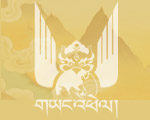 The
Kingdom of Bhutan covers a narrow strip of land in the eastern
Himalayas between the Indian and Chinese sub-continents. Total
land area is approximately 46,500 square kilometers, at their
widest points length and breadth measure about 300 and 150 kilometers
respectively. The rolling landscape forms a staircase, rising
sharply from a low of 100 to a high of 7750 meters above sea
level, which may be divided into three distinct relief and climatic
zones: the thin sub-tropical lowlands of the south, the broad
temperate central valleys and the mountainous alpine north.
Rainfall is concentrated in the monsoon season, mid-June to
September, and can differ significantly within short distances
due to rain shadow effects. Inside this territory are interspersed
an array of particular ecosystems, possessing specific blends
of altitude, climate and terrain. The
Kingdom of Bhutan covers a narrow strip of land in the eastern
Himalayas between the Indian and Chinese sub-continents. Total
land area is approximately 46,500 square kilometers, at their
widest points length and breadth measure about 300 and 150 kilometers
respectively. The rolling landscape forms a staircase, rising
sharply from a low of 100 to a high of 7750 meters above sea
level, which may be divided into three distinct relief and climatic
zones: the thin sub-tropical lowlands of the south, the broad
temperate central valleys and the mountainous alpine north.
Rainfall is concentrated in the monsoon season, mid-June to
September, and can differ significantly within short distances
due to rain shadow effects. Inside this territory are interspersed
an array of particular ecosystems, possessing specific blends
of altitude, climate and terrain.
The country possesses a wealth of natural resources. Water
is abundant, with the altitudinal differences providing a
great potential for hydropower generation. While the exact
magnitude of mineral resources is unknown, geological mapping
has indicated coal, limestone, dolomite, talc, marble, gypsum,
slate, zinc, lead, copper, tungsten and quartzite deposits.
The essentially mountainous landscape harbors immense ecological
riches. Indeed, situated at the interface of several floral
and faunal regions, Bhutan is much better endowed in plant
and animal varieties than any of its neighbors. 72% of land
area is under forest cover and over 60% of the endemic species
of the Eastern Himalayan region can be found within its borders,
including over 165 species of mammals, 770 species of birds,
600 species of orchid, 50 species of rhododendron and 300
species of medicinal plants. In this light, Bhutan has been
declared as one of ten global "hot-spots" for the
conservation of biodiversity, potentially the last best chance
for conservation in the Eastern Himalayas.
Any attempt to summarize such multiplicity is likely to become
fragmented, due to both a lack of space and the limited amount
of research currently conducted. Plant life is sheltered within
huge tracts of forest, its nature corresponding roughly with
the different relief and climatic zones. In the tropical and
sub-tropical south perennial evergreens - with wild banana,
fig and wool-trees - quickly make way for oak, sal, walnut
and cherry. At about 1500m one encounters the first treelike
rhododendrons. Moving into the temperate zone, between 1800
and 3500m, there is again an immense localized diversity changing
within and between valleys. Poplar, willow, ash, magnolia
and more rhododendron are found amongst dominant oak, birch
and maple shifting to spruce, yew, weeping cypress, juniper,
larch, fir and blue pine. The landscape of blue pine and dwarfed
higher altitude varieties converts to alpine meadows above
the tree line at 4500m.
Over 5000 species of plant have been identified within Bhutan.
There is an immense array of orchids, found anywhere up to
3700m. The Blue Poppy, the national flower, grows within the
high altitude rocky terrain, blooming only once over a life
span of several years. In spring, and again during the monsoon,
the alpine meadows are carpeted with an immense vibrancy of
wild flowers - including anemone, primula, delphinium, iris
and forget-me-not. Many natural products, especially in mountain
regions, satisfy some practical purpose. Aside from timber
and fuel, wild plants are used in traditional medicine, for
cooking and handicrafts. Bhutanese medicine - influenced by
Indian Ayurvedic and Chinese pulse reading methods - is similar
to traditional Tibetan techniques, using preparations based
on vegetable, animal and mineral substances. Several ferns
are used in Bhutanese cuisine, and the buds of a certain orchid
are a delicacy. The bark of edgeworthia and daphne is used
to make high-quality paper, lemongrass is harvested for its
essential oil, the weeping cypress is valued for producing
incense.
Animal life is equally varied, including several high profile
endangered species. A number of groups are now totally protected
- these include the golden mahseer, Rufous-necked hornbill,
monal pheasant, black-necked crane, musk deer, pygmy hog,
takin, red panda, golden langur, Himalayan black bear, clouded
and snow leopards, tiger and Asian elephant. The lakes and
rivers support a rich variety of fish - although 42 species
have been recorded, possibly another 200 exist. There is an
immense assortment of birds, some of which have gained cultural
significance. The god Mahakala is believed to have assumed
the form of a raven to guide the Shabdrung to Bhutan and the
crown worn by respective Kings carries the same creature.
Mammals are in abundance, protected in secluded forests and
high plateaus and by Buddhist beliefs. Yaks are the central
livelihood for nomadic herders, wild boars destroy crops,
bears are common threats. The national animal is the takin
- a strange looking moose-like creature - herding in the summer
on alpine pastures, wintering in isolation within dense forests.
The shy snow leopard roams solitary in the thin high altitude
air. There have been numerous claimed sightings of the yeti,
the mythical Himalayan beast.
|



